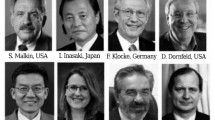Abstract
The high hardness and irregular characteristics of laser hardening free-form surface bring many problems into the finishing process. A new autofinishing method based on softness consolidation abrasives (SCA), oriented to laser hardening surface, is brought forward. Abrasives are consolidated on the rubber bonnet by the polymer binder, which have micromovement under the elastic restraint to form stress concentration for cutting. By the modification of coefficients and stress, the material removal model is given by the modified Preston equation. According to a series of simulation and practical experiments, the size of abrasive, hardness of abrasive, and hardness of surface were derived as important factors for the material removal. The empirical results showed that the modified Preston equation is propitious to avoid errors for calculation. Compared with free abrasive methods, it demonstrated that SCA can help to improve at least 13.6 % of efficiency.
Similar content being viewed by others
References
Jiwang Y, Jun M, Takashi O, Tsunemoto K (2011) Investigation on shape transferability in ultraprecision glass moulding press for microgrooves. Precis Eng 35:2014–2023
Sunil J, Jain VK (2009) Rheological characterization of magnetorheological polishing fluid for MRAFF. Int J Adv Manuf Technol 42:656–668
Kim JD, Lee MH, Lee SJ, Kang WJ (2009) Laser transformation hardening on rod-shaped carbon steel by Gaussian beam. Trans Nonferrous Met Soc China 19:941–945
Torkamany MJ, Sabbaghzadeh J, Hamedi MJ (2012) Effect of laser welding mode on the microstructure and mechanical performance of dissimilar laser spot welds between low carbon and austenitic stainless steels. Mater Des 34:666–672
Das M, Jain VK, Ghoshdastidar PS (2008) Analysis of magnetorheological abrasive flow finishing (MRAFF) process. Int J Adv Manuf Technol 38:613–621
Kwok CT, Leong KI, Cheng FT, Man HC (2003) Microstructural and corrosion characteristics of laser surface-melted plastics mould steels. Mater Sci Eng A 357:94–103
Zhong ZW, Leong MH, Liu XD (2012) The wear rates and performance of three mould insert materials. Mater Des 32:643–648
Zhang S, Li JF (2010) Tool wear criterion, tool life, and surface roughness during high-speed end milling Ti-6Al-4V alloy. Zhejiang Univ Sci A 11:587–595
Wu HB, Jia ZX, Liu G, Bi YB, Dong HY (2010) Finite element modeling of Ti6Al4V alloy high speed cutting. Zhejiang Daxue Xuebao (Gongxue Ban) 44:982–987
Toh CK (2005) Design evaluation and optimisation of cutter path strategies when high speed machining hardened mould and die materials. Mater Des 26:517–533
Li DM, Li L, Ma XY (2006) Research of auto-polishing free-curve-surface of moulds experiment. Mod Mach Tool Auto Manuf Tec 28:86–88
Dai YF, Zhang XC, Li SY, Peng XQ (2009) Deterministic magneto rheological jet polishing technology. Chinese J Mech Eng 45:171–176
Kuriyagawa T, Saeki M, Syoji K (2002) Electrorheological fluid-assisted polishing for small three-dimensional parts. Precis Eng 26:370–380
Luo Q, Ramarajan S, Babu SV (1998) Modifcation of the Preston equation for the chemical–mechanical polishing of copper. Thin Solid Films 335:160–167
Wrschka P, Hernandez J, Hsu Y, Kuan TS, Oehrlein GS, Sun HJ, Hansen DA, King J, Fury MA (1999) Polishing parameter dependencies and surface oxidation of chemical mechanical polishing of al thin films. J Electrochem Soc 146:2689–2696
Tseng WT, Wang YL (1997) Re-examination of pressure and speed dependences of removal rate during chemical–mechanical polishing processes. J Electrochem Soc 144:15–17
Luo H, Liu JJ, Zhu BL, Cheng WT, Zhang ZJ (1994) Sliding abrasive wear characteristics of steels with different hardness. Mocaxue Xuebao 14:213–219
Ji SM, Li C, Tan DP, Yuan QL, Chi YW, Zhao LH (2011) Study on machinability of softness abrasive flow based on Preston equation. Chinese J Mech Eng 47:156–163
Shi FG, Zhao B (1998) Modeling of chemical–mechanical polishing with soft pads. Appl Phys A 67:249–252
Tong L, Xie KH, Lu MM, Wang K (2010) Elastic complex variables solution for general arbitrary ground deformation of tunnels in clays. J Zhejiang University 44:1825–1830
Jin MS (2009) Gasbag polishing mechanism and process on free-form surface mould. ZheJiang University of Technology, Hangzhou, pp 69–83
Author information
Authors and Affiliations
Corresponding author
Rights and permissions
About this article
Cite this article
Zeng, X., Ji, Sm., Tan, Dp. et al. Softness consolidation abrasives material removal characteristic oriented to laser hardening surface. Int J Adv Manuf Technol 69, 2323–2332 (2013). https://doi.org/10.1007/s00170-013-4985-y
Received:
Accepted:
Published:
Issue Date:
DOI: https://doi.org/10.1007/s00170-013-4985-y



